Responding to Visitor Density Pre and Post COVID-19 Outbreak: The Impact of Personality Type on Perceived Crowdedness, Feeling of Being Comfortable, and Anticipated Experience
Abstract
:1. Introduction
2. Study Background
2.1. COVID-19 Outbreak: PRE and POST Periods
2.2. Visitors’ Density and Perceived Crowding
RQ1. Did the perception of crowdedness (1a), feeling of being comfortable (1b), and anticipated experience (1c) at destinations change after the COVID-19 outbreak?
2.3. Personality
RQ2. Do people with different personality profiles differ in their perception of crowdedness (2a), the feeling of being comfortable (2b), and anticipated experience (2c) at destinations?
RQ3. Does the PRE–POST-COVID-19 outbreak change in perception of crowdedness (3a), feeling of being comfortable (3b), and anticipated experience (3c) at destinations depend on the personality profile of the individual?
3. Method
3.1. Overall Study Design
3.2. Measuring Personality Profile
3.3. Selection of Images
- Beaches: Miami Beach (USA), La Concha Beach (Spain), Magaluf Beach (Spain), Clearwater Beach (USA), Biscarrosse Beach (France).
- Historic sites: The Great Wall of China (China), Angkor Wat (Cambodia), the ancient city of Ephesus (Turkey), the Colosseum of Rome (Italy), and the Taj Mahal (India).
- Museums: Uffizi Gallery (Italy), the British Museum (UK), the Metropolitan Museum (USA), the Louvre Museum (France), the Natural History Museum (UK).
3.4. Online Survey
4. Results
4.1. PRE and POST Samples Profiles
4.2. Manifest Variables of Personality Traits and Anticipated Experience
4.3. Personality Profile Clusters
4.4. Effectiveness of Experimental Manipulation of Density Levels on the Photographs
4.5. Research Question 1
4.6. Research Question 2
4.7. Research Question 3
5. Discussion
5.1. Methodological Considerations, Limitations, and Future Research
5.2. Conclusions
Author Contributions
Funding
Institutional Review Board Statement
Informed Consent Statement
Data Availability Statement
Acknowledgments
Conflicts of Interest
References
- UNWTO. World Tourism Barometer. 2020. Available online: https://www.unwto.org/publications (accessed on 14 April 2020).
- Stanchev, R. The Most Affected European Destinations by Over-Tourism. Universitat De Les Illes Balears, Spain. 2018. Available online: http://hdl.handle.net/11201/148140 (accessed on 24 February 2022).
- McKinsey & Company. Coping with Success: Managing Overcrowding in Tourist Destinations. World Travel and Tourism Council, New York. 2017. Available online: https://www.mckinsey.com/industries/travel-transport-and-logistics/our-insights/coping-with-success-managing-overcrowding-in-tourism-destinations (accessed on 24 February 2022).
- Gössling, S.; Scott, D.; Hall, C.M. Pandemics, tourism and global change: A rapid assessment of COVID-19. J. Sustain. Tour. 2020, 29, 1–20. [Google Scholar] [CrossRef]
- UNWTO. Impact Assessment of the COVID 19 Outbreak on International Tourism. 2020. Updated May 2020. Available online: https://www.unwto.org/impact-assessment-of-the-covid-19-outbreak-on-international-tourism (accessed on 24 February 2022).
- Higgins-Desbiolles, F. Socialising tourism for social and ecological justice after COVID-19. Tour. Geogr. 2020, 22, 610–623. [Google Scholar] [CrossRef] [Green Version]
- Dolnicar, S. Webinar communication. In The Future of Tourism Research in a Post-Pandemic World; Temple University: Philadelphia, PA, USA, 20 May 2020. [Google Scholar]
- Flin, R.; Slaven, G. Personality and emergency command ability. Disaster Prev. Manag. 1996, 5, 40–46. [Google Scholar] [CrossRef]
- Kendler, K.S.; Kuhn, J.; Prescott, C.A. The interrelationship of neuroticism, sex, and stressful life events in the prediction of episodes of major depression. Am. J. Psychiatry 2004, 161, 631–636. [Google Scholar] [CrossRef] [PubMed]
- Qiu, J.; Shen, B.; Zhao, M.; Wang, Z.; Xie, B.; Xu, Y. A nationwide survey of psychological distress among Chinese people in the COVID-19 epidemic: Implications and policy recommendations. Gen. Psychiatry 2020, 33, e100213. [Google Scholar] [CrossRef] [Green Version]
- Wen, J.; Kozak, M.; Yang, S.; Liu, F. COVID-19: Potential effects on Chinese citizens’ lifestyle and travel. Tour. Rev. 2020, 76, 1660–5373. [Google Scholar] [CrossRef]
- People.com. 4 May 2020. Claudia Harmata. Streets in Italy and Spain Surge with People As Coronavirus Restrictions Are Eased. Available online: https://people.com/travel/streets-in-italy-and-spain-surge-with-people-as-coronavirus-restrictions-are-eased/ (accessed on 4 February 2022).
- BBC News. May 2020. Coronavirus: Resort Locals ‘Shocked and Angry’ at Beach Crowds. Available online: https://www.bbc.com/news/uk-england-52754039 (accessed on 4 February 2022).
- The NYT. After Crowding at Lake of the Ozarks, Missouri Officials Urge Quarantine. 26 May 2020. Available online: https://www.nytimes.com/2020/05/26/us/lake-of-the-ozarks-coronavirus.html (accessed on 4 February 2022).
- Huang, L.; Gursoy, D.; Xu, H. Impact of personality traits and involvement on prior knowledge. Ann. Tour. Res. 2014, 48, 42–57. [Google Scholar] [CrossRef]
- Harrell, G.D.; Hutt, M.D. Buyer Behavior under Conditions of Crowding: An Initial Framework. Adv. Consum. Res. 1976, 3, 36–39. [Google Scholar]
- Mehta, R.; Sharma, N.K.; Swami, S. The impact of perceived crowding on consumers’ store patronage intentions: Role of optimal stimulation level and shopping motivation. J. Mark. Manag. 2013, 29, 812–835. [Google Scholar] [CrossRef]
- WHO (n.d.). Desease Outbreaks. Available online: https://www.who.int/teams/environment-climate-change-and-health/emergencies/disease-outbreaks (accessed on 24 February 2022).
- Mangan, D. Trump Dismissed Coronavirus Pandemic Worry in January—Now Claims He Long Warned about it. CNBC. 17 March 2020. Available online: https://www.cnbc.com/2020/03/17/trump-dissed-coronavirus-pandemic-worry-now-claims-he-warned-about-it.html (accessed on 24 February 2022).
- CDC. 2020. Coronavirus Disease 2019 (COVID-19). Centers for Decease Control and Prevention. Available online: https://www.cdc.gov/coronavirus/2019-ncov/cases-updates/cases-in-us.html (accessed on 24 February 2022).
- WHO 2020. Coronavirus disease 2019 (COVID-19) Situation Report #35. Available online: https://www.who.int/docs/default-source/coronaviruse/situation-reports/20200224-sitrep-35-covid-19.pdf (accessed on 24 February 2022).
- Worldometers. 2020. COVID-19 Coronavirus Pandemic. Available online: https://www.worldometers.info/coronavirus/ (accessed on 24 February 2022).
- AP-NORC. Few Americans Worry about Coronavirus Infection. The Associated Press-NORC Center for Public Affairs Research. Available online: http://www.apnorc.org/Pages/Few-Americans-Worry-about-Coronavirus-Infection-.aspx (accessed on 24 February 2022).
- Maccarthy, J. High Confidence in Government to Handle Coronavirus. Gallup News. 20 February 2020. Available online: https://news.gallup.com/poll/286277/high-confidence-government-handle-coronavirus.aspx (accessed on 24 February 2022).
- Bycoffe, A.; Groskopf, C.; Mehta, D. How Americans View The Coronavirus Crisis And Trump’s Response. FiveThirtyEight. 22 May 2020. Available online: http://projects.fivethirtyeight.com/coronavirus-polls/ (accessed on 24 February 2022).
- CDC@CDC.gov. COVID-19: Should I Wear a Mask? 27 February 2020. Available online: https://twitter.com/cdcgov/status/1233134710638825473 (accessed on 4 February 2022).
- Science News Staff. 2020. This COVID-19 Pandemic Timeline Shows How Fast the Coronavirus Took over Our Lives. Science News. 11 December 2020. Available online: https://www.sciencenews.org/article/coronavirus-covid19-pandemic-timeline-events (accessed on 24 February 2022).
- Gallup. Gallup’s Data Brief on COVID-19. March 2020. Available online: https://news.gallup.com/opinion/gallup/305741/gallup-data-brief-covid.aspx (accessed on 24 February 2022).
- Shelby, B. Crowding models for backcountry recreation. Land. Econ. 1980, 56, 43–55. [Google Scholar] [CrossRef]
- Stokols, D. A social psychological model of human crowding phenomena. J. Am. Inst. Plan. 1972, 38, 72–83. [Google Scholar] [CrossRef]
- Shelby, B.; Heberlein, T.A. A conceptual framework for carrying capacity determination. Leis. Sci. 1984, 6, 433–451. [Google Scholar] [CrossRef]
- Vaske, J.J.; Donnelly, M.P. Generalizing the encounter--norm—Crowding relationship. Leis. Sci. 2002, 24, 255–269. [Google Scholar] [CrossRef]
- Milgram, S. The experience of living in cities: A psychological analysis. In Psychology and the Problems of Society; Korten, F.F., Cook, S.W., Lacey, J.I., Eds.; American Psychological Association: Washington, DC, USA, 1970; pp. 152–173. [Google Scholar]
- Averill, J.R. Personal control over aversive stimuli and its relationship to stress. Psychol. Bull. 1973, 80, 286. [Google Scholar] [CrossRef]
- Schreyer, R.; Roggenbuck, J.W. The influence of experience expectations on crowding perceptions and social-psychological carrying capacities. Leis. Sci. 1978, 1, 373–394. [Google Scholar] [CrossRef]
- Westover, T.N. Perceived crowding in recreational settings: An environment-behavior model. Environ. Behav. 1989, 21, 258–276. [Google Scholar] [CrossRef]
- Vaske, J.J.; Donnely, M.P.; Heberlein, T.A. Perceptions of crowding and resource quality by early and more recent visitors. Leis. Sci. 1980, 3, 367–381. [Google Scholar] [CrossRef]
- Vaske, J.J.; Shelby, B.B.; Graefe, A.R.; Heberlein, T.A. Backcountry encounter norms: Theory, method and empirical evidence. J. Leis. Res. 1986, 18, 137–153. [Google Scholar] [CrossRef]
- Shelby, B.; Vaske, J.J.; Heberlein, T.A. Comparative analysis of crowding in multiple locations: Results from fifteen years of research. Leis. Sci. 1989, 11, 269–291. [Google Scholar] [CrossRef]
- Hall, T.; Shelby, B. Temporal and spatial displacement: Evidence from a high-use reservoir and alternate sites. J. Leis. Res. 2000, 32, 435–456. [Google Scholar] [CrossRef]
- Hwang, J.; Yoon, S.Y.; Bendle, L.J. Desired privacy and the impact of crowding on customer emotions and approach-avoidance responses. Int. J. Contemp. Hosp. Manag. 2012, 24, 224–250. [Google Scholar] [CrossRef]
- Morgan, D.J.; Lok, L. Assessment of a comfort indicator for natural tourist attractions: The case of visitors to Hanging Rock, Victoria. J. Sustain. Tour. 2000, 8, 393–409. [Google Scholar] [CrossRef]
- Popp, M. Positive and negative urban tourist crowding: Florence, Italy. Tour. Geogr. 2012, 14, 50–72. [Google Scholar] [CrossRef]
- Zehrer, A.; Raich, F. The impact of perceived crowding on customer satisfaction. J. Hosp. Tour. Manag. 2016, 29, 88–98. [Google Scholar] [CrossRef]
- Cutler, S.Q.; Carmichael, B.A. The dimensions of the tourist experience. In The Tourism and Leisure Experience; Channel View Publications: Bristol, UK, 2010; pp. 3–26. [Google Scholar]
- Hosany, S.; Witham, M. Dimensions of cruisers’ experiences, satisfaction, and intention to recommend. J. Travel Res. 2010, 49, 351–364. [Google Scholar] [CrossRef]
- Jung, T.; tom Dieck, M.C.; Lee, H.; Chung, N. Effects of virtual reality and augmented reality on visitor experiences in museum. In Information and Communication Technologies in Tourism; Springer: Cham, Switzerland, 2016; pp. 621–635. [Google Scholar]
- Luque-Gil, A.M.; Gómez-Moreno, M.L.; Peláez-Fernández, M.A. Starting to enjoy nature in Mediterranean mountains: Crowding perception and satisfaction. Tour. Manag. Perspect. 2018, 25, 93–103. [Google Scholar] [CrossRef]
- D’Antonio, A.; Monz, C.; Newman, P.; Lawson, S.; Taff, D. The effects of local ecological knowledge, minimum-impact knowledge, and prior experience on visitor perceptions of the ecological impacts of backcountry recreation. Environ. Manag. 2012, 50, 542–554. [Google Scholar] [CrossRef]
- Brown, A.; Kappes, J.; Marks, J. Mitigating theme park crowding with incentives and information on mobile devices. J. Travel Res. 2013, 52, 426–436. [Google Scholar] [CrossRef]
- Shi, B.; Zhao, J.; Chen, P.J. Exploring urban tourism crowding in Shanghai via crowdsourcing geospatial data. Curr. Issues Tour. 2017, 20, 1186–1209. [Google Scholar] [CrossRef]
- Cabrera-Quiros, L.; Gedik, E.; Hung, H. Multimodal self-assessed personality estimation during crowded mingle scenarios using wearables devices and cameras. IEEE Trans. Affect. Comput. 2019, 13, 46–59. [Google Scholar] [CrossRef]
- Miller, S.; Nardini, K.M. Individual differences in the perception of crowding. Environ. Psychol. Nonverbal Behav. 1977, 2, 3–13. [Google Scholar] [CrossRef]
- Landers, R.N.; Lounsbury, J.W. An investigation of Big Five and narrow personality traits in relation to Internet usage. Comput. Hum. Behav. 2006, 22, 283–293. [Google Scholar] [CrossRef]
- Ardelt, M. Still stable after all these years? Personality stability theory revisited. Soc. Psychol. Q. 2000, 63, 392–405. [Google Scholar] [CrossRef]
- McCrae, R.R.; Costa, P.T. Self-concept and the stability of personality: Cross-sectional comparisons of self-reports and ratings. J. Personal. Soc. Psychol. 1982, 43, 1282. [Google Scholar] [CrossRef]
- Donnellan, M.B.; Lucas, R.E. Age differences in the Big Five across the life span: Evidence from two national samples. Psychol. Aging 2008, 23, 558. [Google Scholar] [CrossRef] [Green Version]
- Srivastava, S.; John, O.P.; Gosling, S.D.; Potter, J. Development of personality in early and middle adulthood: Set like plaster or persistent change? J. Personal. Soc. Psychol. 2003, 84, 1041. [Google Scholar] [CrossRef] [Green Version]
- Terracciano, A.; Costa, P.T., Jr.; McCrae, R.R. Personality plasticity after age 30. Personal. Soc. Psychol. Bull. 2006, 32, 999–1009. [Google Scholar] [CrossRef] [Green Version]
- Eysenck, H.J. The Structure of Human Personality, Psychology Revivals; Routledge: New York, NY, USA, 2013. [Google Scholar]
- Myers, I.B. The Myers-Briggs Type Indicator: Manual; Consulting Psychologists Press: Palo Alto, CA, USA, 1962. [Google Scholar]
- Rotter, J.B. Generalized expectancies for internal versus external control of reinforcement. Psychol. Monogr. Gen. Appl. 1966, 80, 1–28. [Google Scholar] [CrossRef] [Green Version]
- Goldberg, L.R. An alternative “description of personality”: The big-five factor structure. J. Personal. Soc. Psychol. 1990, 59, 1216. [Google Scholar] [CrossRef]
- Furnham, A.; Mouttafi, J.; Crump, J. The Relationship between the Revised NEO-Personality Inventory and the Myers-Briggs Type Indicator. Soc. Behav. Personal. 2003, 31, 577–584. [Google Scholar] [CrossRef]
- Nießen, D.; Danner, D.; Spengler, M.; Lechner, C.M. Big Five Personality Traits Predict Successful Transitions From School to Vocational Education and Training: A Large-Scale Study. Front. Psychol. 2020, 11, 1827. [Google Scholar] [CrossRef]
- Gosling, S.D.; Rentfrow, P.J.; Swann, W.B., Jr. A very brief measure of the Big-Five personality domains. J. Res. Personal. 2003, 37, 504–528. [Google Scholar] [CrossRef]
- Goldberg, L.R. The structure of phenotypic personality traits. Am. Psychol. 1993, 48, 26. [Google Scholar] [CrossRef]
- Kvasova, O. The Big Five personality traits as antecedents of eco-friendly tourist behavior. Personal. Individ. Differ. 2015, 83, 111–116. [Google Scholar] [CrossRef]
- Lepp, A.; Gibson, H. Sensation seeking and tourism: Tourist role, perception of risk and destination choice. Tour. Manag. 2008, 29, 740–750. [Google Scholar] [CrossRef]
- Jani, D. Relating travel personality to Big Five Factors of personality. Tour. Int. Interdiscip. J. 2014, 62, 347–359. [Google Scholar]
- Schneider, P.P.; Vogt, C.A. Applying the 3M model of personality and motivation to adventure travelers. J. Travel Res. 2012, 51, 704–716. [Google Scholar] [CrossRef]
- Yoo, K.H.; Gretzel, U. Influence of personality on travel-related consumer-generated media creation. Comput. Hum. Behav. 2011, 27, 609–621. [Google Scholar] [CrossRef]
- Zuckerman, M.; Kuhlman, D.M. Personality and risk-taking: Common bisocial factors. J. Personal. 2000, 68, 999–1029. [Google Scholar] [CrossRef] [PubMed]
- Abdelrahman, M. Personality traits, risk perception, and protective behaviors of Arab residents of Qatar during the COVID-19 pandemic. Int. J. Ment. Health Addict. 2020, 20, 237–248. [Google Scholar] [CrossRef] [PubMed]
- Kim, H.; Stepchenkova, S. Effect of tourist photographs on attitudes towards destination: Manifest and latent content. Tour. Manag. 2015, 49, 29–41. [Google Scholar] [CrossRef]
- Berinsky, A.J.; Huber, G.A.; Lenz, G.S. Evaluating online labor markets for experimental research: Amazon. com’s Mechanical Turk. Political Anal. 2012, 20, 351–368. [Google Scholar] [CrossRef] [Green Version]
- Paolacci, G.; Chandler, J.; Ipeirotis, P.G. Running experiments on amazon mechanical turk. Judgm. Decis. Mak. 2010, 5, 411–419. [Google Scholar]
- McCredie, M.N.; Morey, L.C. Who are the Turkers? A characterization of MTurk workers using the personality assessment inventory. Assessment 2019, 26, 759–766. [Google Scholar] [CrossRef]
- We Are Dynamo, 2014. Guidelines for Academic Requesters, Version 1.1. Available online: http://www.wearedynamo.org/Guidelines_for_Academic_Requesters.pdf (accessed on 14 April 2020).
- IPIP. International Personality Item Pool: A Scientific Collaboratory for the Development of Advanced Measures of Personality Traits and Other Individual Differences. 2008. Available online: http://ipip.ori.org/ (accessed on 22 June 2021).
- Goldberg, L.R. A broad-bandwidth, public domain, personality inventory measuring the lower-level facets of several five-factor models. Personal. Psychol. Eur. 1999, 7, 7–28. [Google Scholar]
- Heberlein, T.A.; Vaske, J.J. Crowding and Visitor Conflict on the Bois Brule River; (report WISC WRC 77–04); University of Wisconsin Water Resources Center: Madison, WI, USA, 1977. [Google Scholar]
- Pine, B.J.; Gilmore, J.H. Welcome to the experience economy. Harv. Bus. Rev. 1998, 76, 97–105. [Google Scholar]
- Oh, H.; Fiore, A.M.; Jeoung, M. Measuring Experience Economy Concepts: Tourism Applications. J. Travel Res. 2007, 46, 119–132. [Google Scholar] [CrossRef]
- Smith, S.M.; Roster, C.A.; Golden, L.L.; Albaum, G.S. A multi-group analysis of online survey respondent data quality: Comparing a regular USA consumer panel to MTurk samples. J. Bus. Res. 2016, 69, 3139–3148. [Google Scholar] [CrossRef]
- Hernández, J.M.; Kirilenko, A.P.; Stepchenkova, S. Network approach to tourist segmentation via user generated content. Ann. Tour. Res. 2018, 73, 35–47. [Google Scholar] [CrossRef]
- Hair, J.F.; Black, W.C.; Babin, B.J.; Anderson, R.E.; Tatham, R. Multivariate Data Analysis; Pearson: Upper Saddle River, NJ, USA, 2006. [Google Scholar]
- Chiu, T.; Fang, D.; Chen, J.; Wang, Y.; Jeris, C. A robust and scalable clustering algorithm for mixed type attributes in large database environment. In KDD’01; ACM Press: New York, NY, USA, 2011; pp. 263–268. [Google Scholar]
- Cohen, J. Statistical Power Analysis for the Behavioral Sciences; Routledge Academic: New York, NY, USA, 1988. [Google Scholar]
- Tabachnick, B.G.; Fidell, L.S.; Ullman, J.B. Using Multivariate Statistics; Pearson: Boston, MA, USA, 2007. [Google Scholar]
- DeYoung, C.G.; Peterson, J.B.; Higgins, D.M. Higher-order factors of the Big Five predict conformity: Are there neuroses of health? Personal. Individ. Differ. 2002, 33, 533–552. [Google Scholar] [CrossRef]
- Wrench, J.S.; Brogan, S.M.; McCroskey, J.C.; Jowi, D. Social communication apprehension: The intersection of communication apprehension and social phobia. Hum. Commun. 2008, 11, 409–429. [Google Scholar]
- Elliott, C. Life after Coronavirus: Ready to Travel as Soon as It’s Safe? So Is Everyone Else. May 2020. Available online: https://www.usatoday.com/story/travel/advice/2020/05/01/coronavirus-why-everyonewant-travel-soon/3058753001/ (accessed on 14 May 2020).
- Skyscanner. Weekly Travel Insights—14 May. 2020. Updated May 2020. Available online: https://www.partners.skyscanner.net/news-case-studies/future-booking-factors (accessed on 24 February 2022).
- Pohle, A. The Cruise Trips Most in Demand Don’t Embark until 2022 and Beyond. Wall Street Journal. Available online: https://www.wsj.com/articles/cruise-ships-2022-covid-delta-carnival-11629403417 (accessed on 20 August 2021).
- Burnham, M.J.; Le, Y.K.; Piedmont, R.L. Who is Mturk? Personal characteristics and sample consistency of these online workers. Ment. Health Relig. Cult. 2018, 21, 934–944. [Google Scholar] [CrossRef]
- Kawamoto, T.; Oshio, A.; Abe, S.; Tsubota, Y.; Hirashima, T.; Ito, H.; Tani, I. Age and Gender Differences of Big Five Personality Traits in a Cross-Sectional Japanese Sample. Jpn. J. Dev. Psychol. 2015, 26, 107–122. [Google Scholar]
- Koch, G.C.; Amara, K.A.; Brown, B.W., Jr.; Colton, T.; Gillings, D.B. A two-period crossover design for the comparison of two active treatments and placebo. Stat. Med. 1983, 8, 487–504. [Google Scholar] [CrossRef]
- Reed, J.F., III. Higher Order C (t, p, s) Crossover Designs. J. Mod. Appl. Stat. Methods 2011, 10, 27. [Google Scholar] [CrossRef] [Green Version]
- Wellek, S.; Blettner, M. On the proper use of the crossover design in clinical trials: Part 18 of a series on evaluation of scientific publications. Dtsch. Ärzteblatt Int. 2012, 109, 276. [Google Scholar]
- Hipp, J.A.; Ogunseitan, O.A. Effect of environmental conditions on perceived psychological restorativeness of coastal parks. J. Environ. Psychol. 2011, 31, 421–429. [Google Scholar] [CrossRef] [Green Version]
- Greenwood, A.; Gatersleben, B. Let’s go outside! Environmental restoration amongst adolescents and the impact of friends and phones. J. Environ. Psychol. 2016, 48, 131–139. [Google Scholar] [CrossRef]
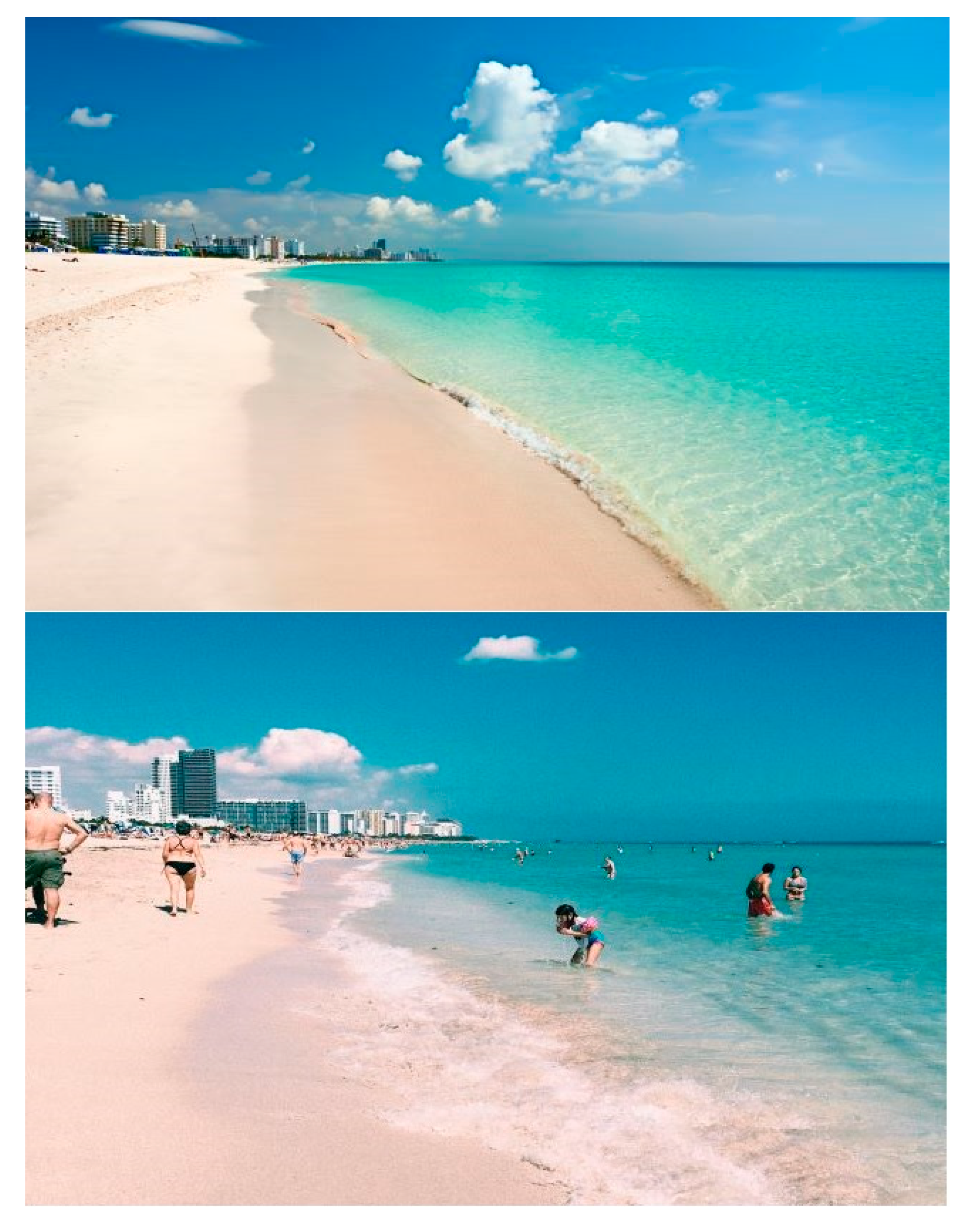
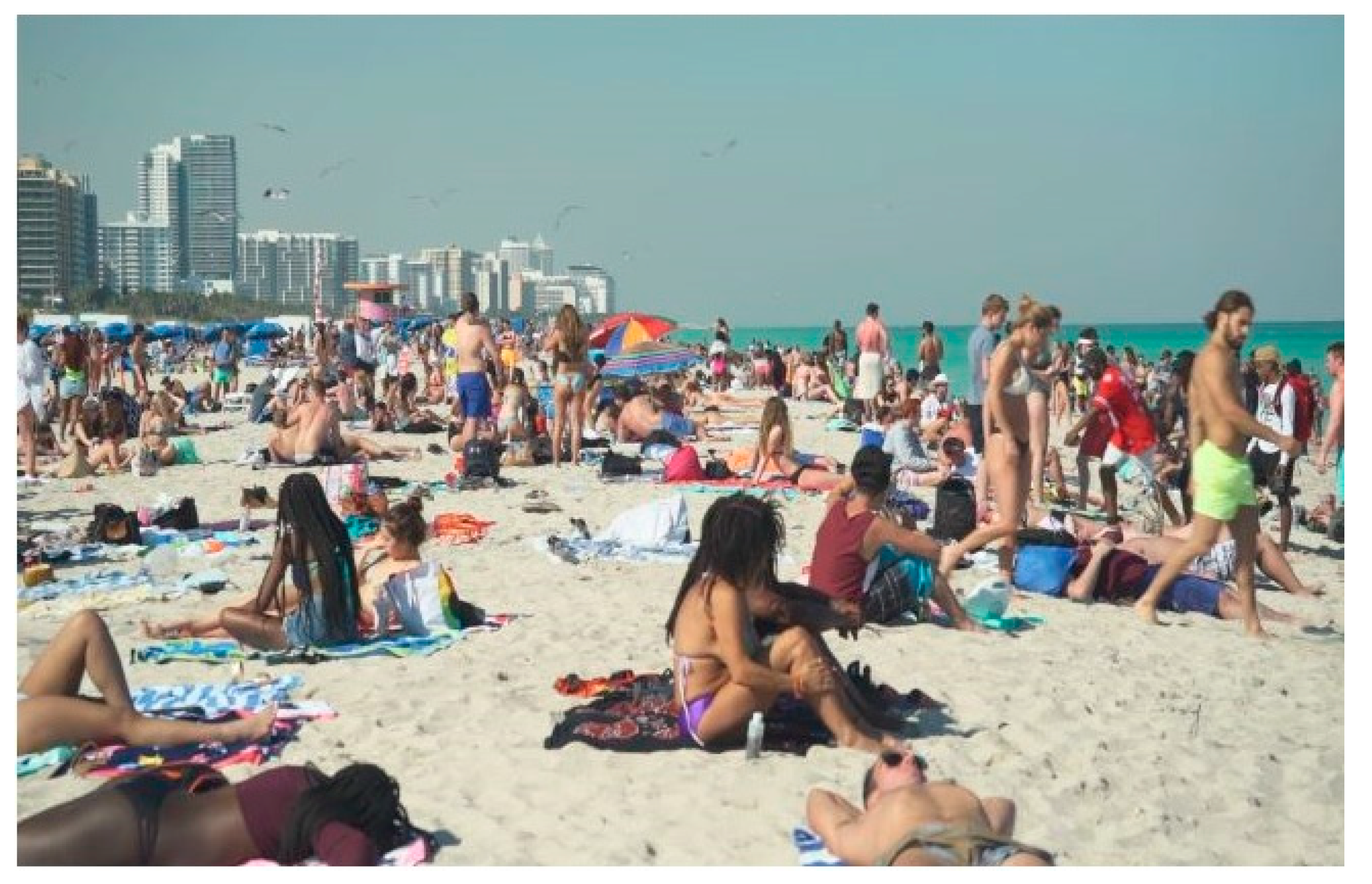
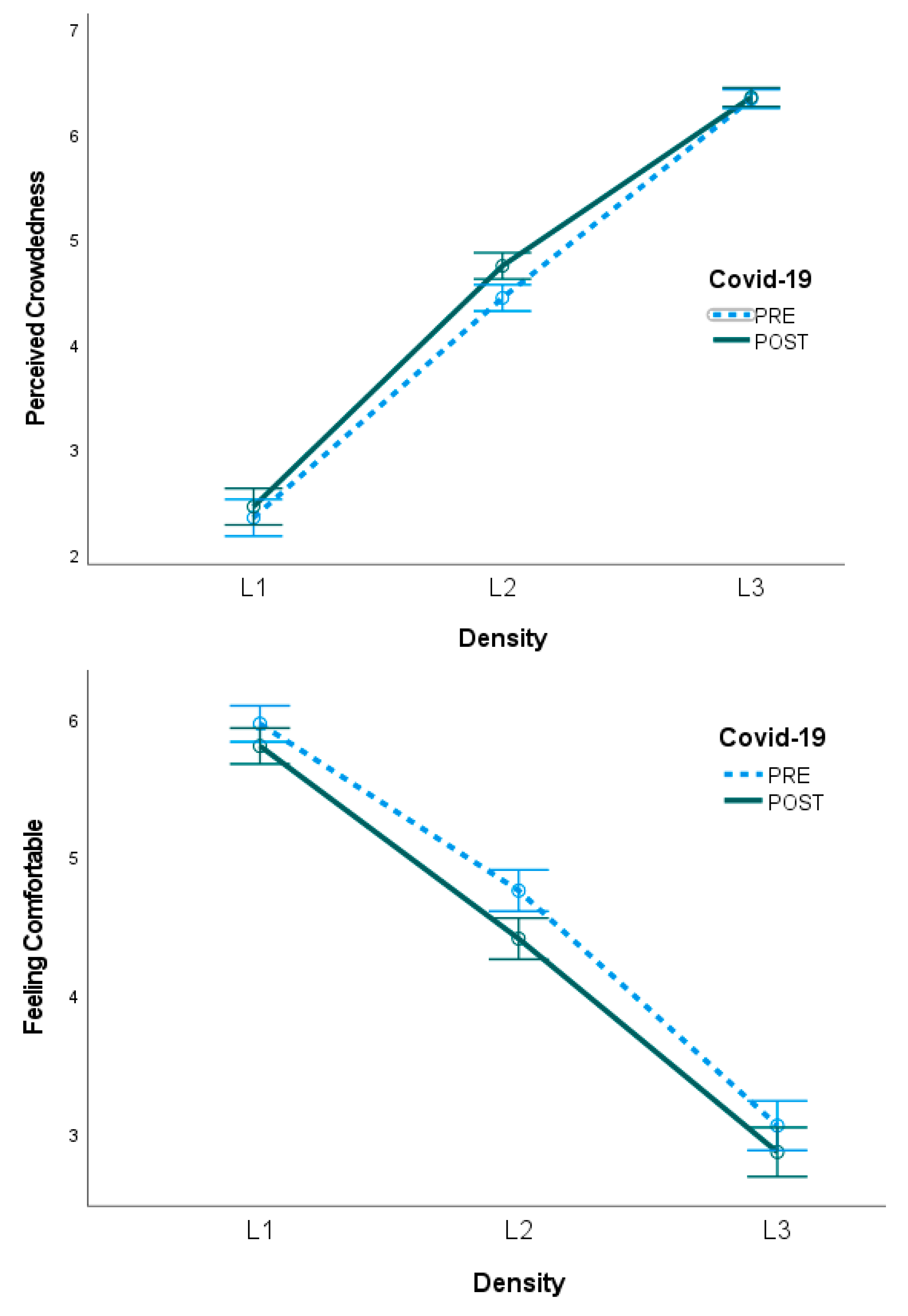
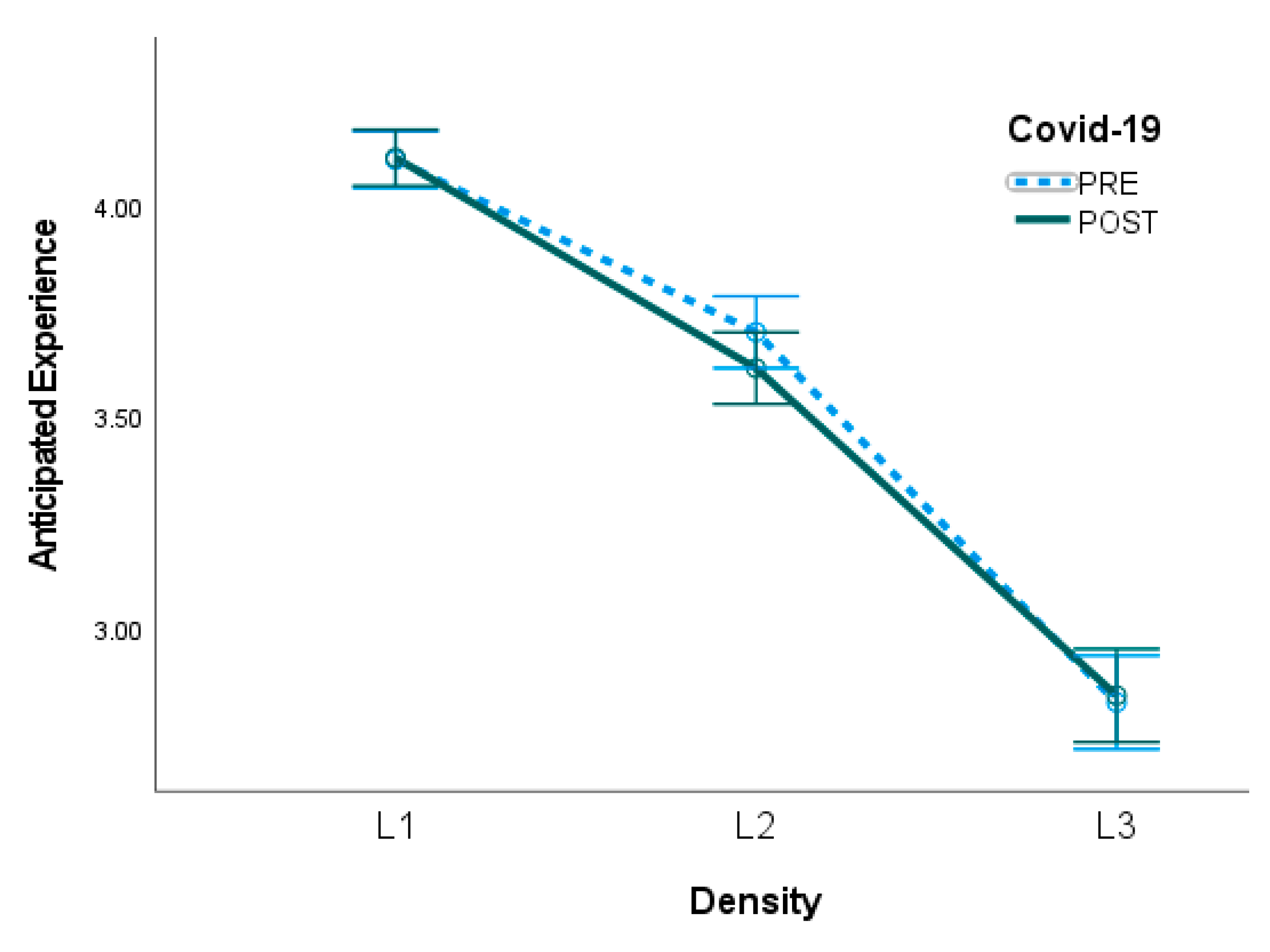
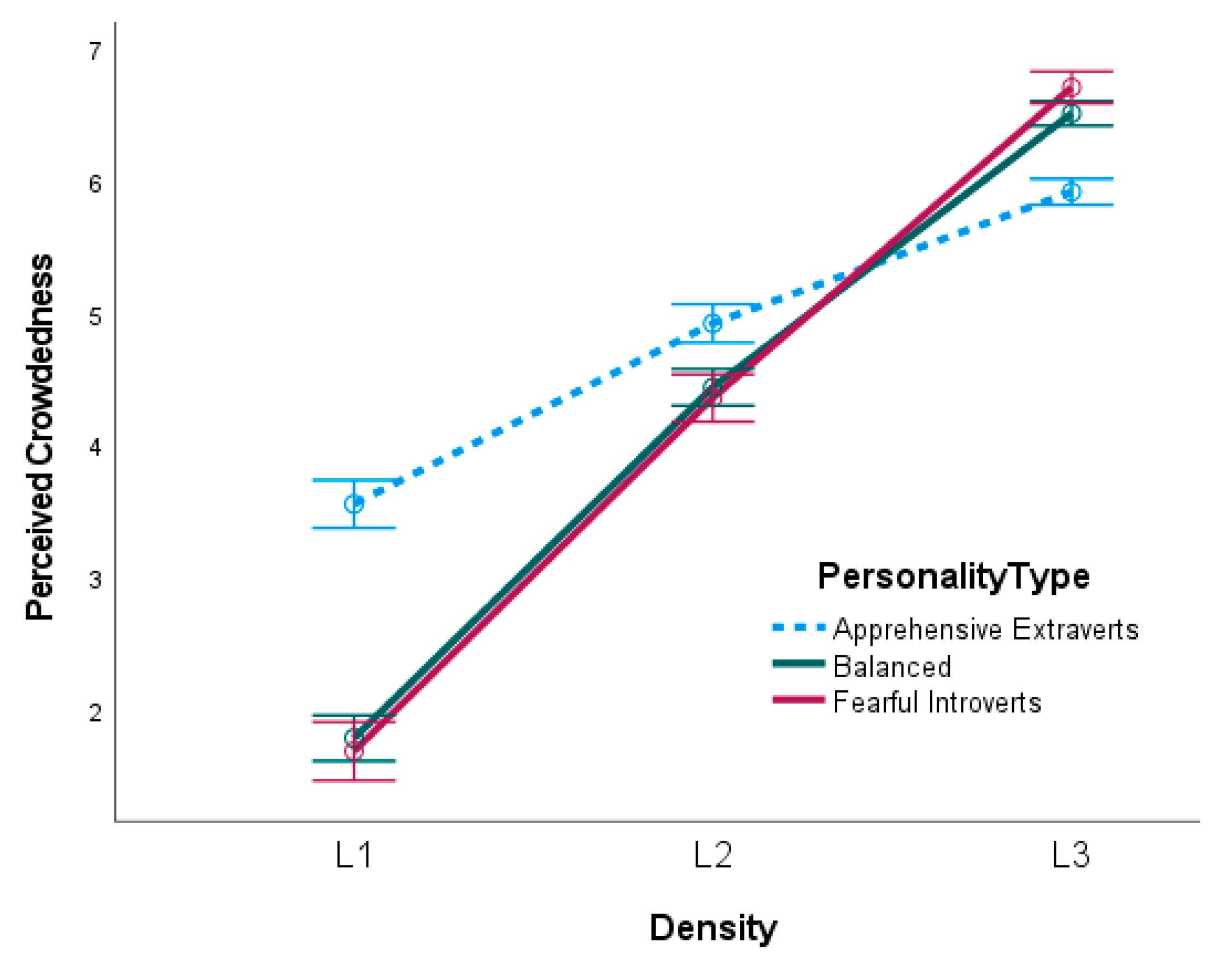
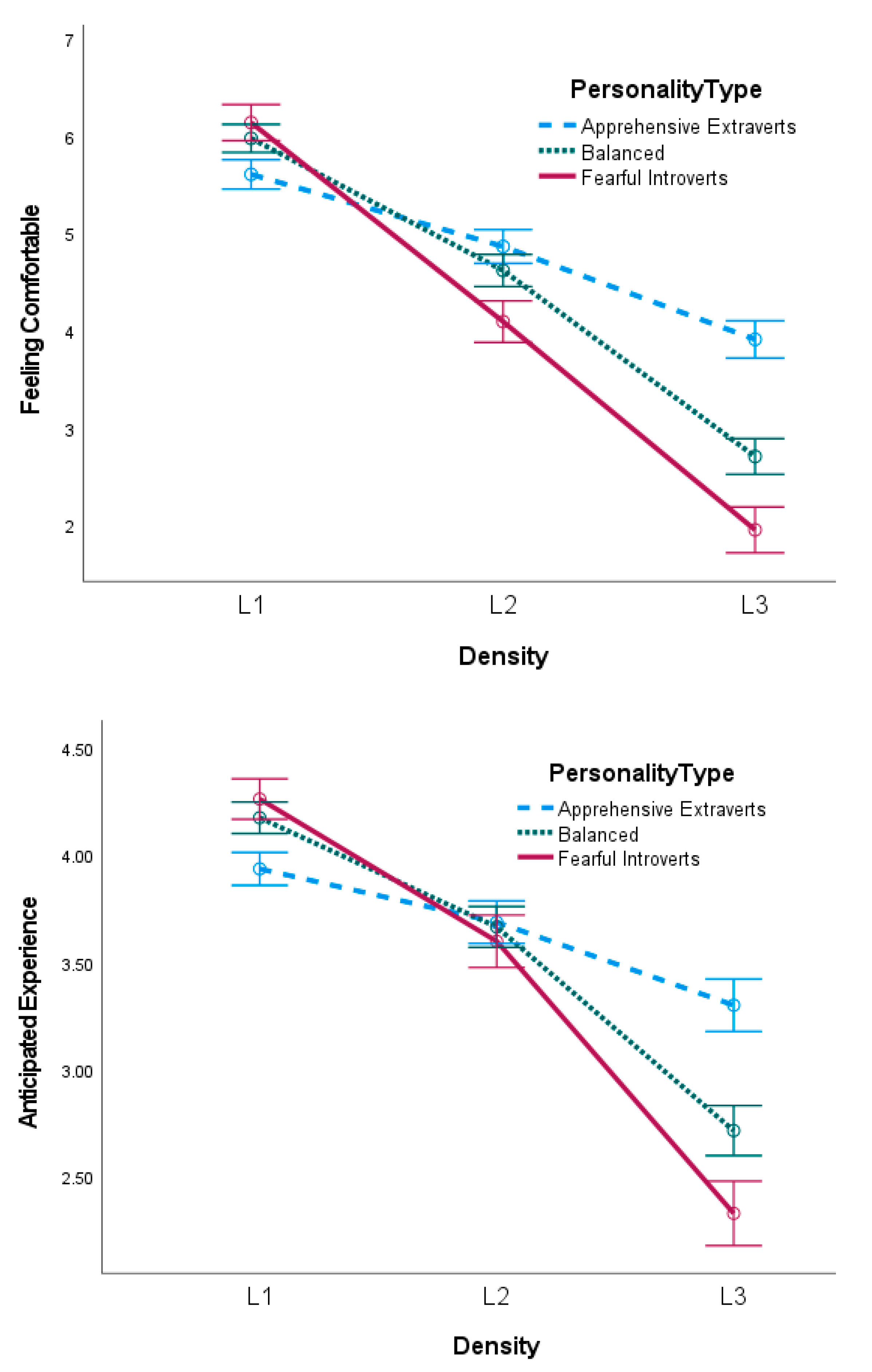

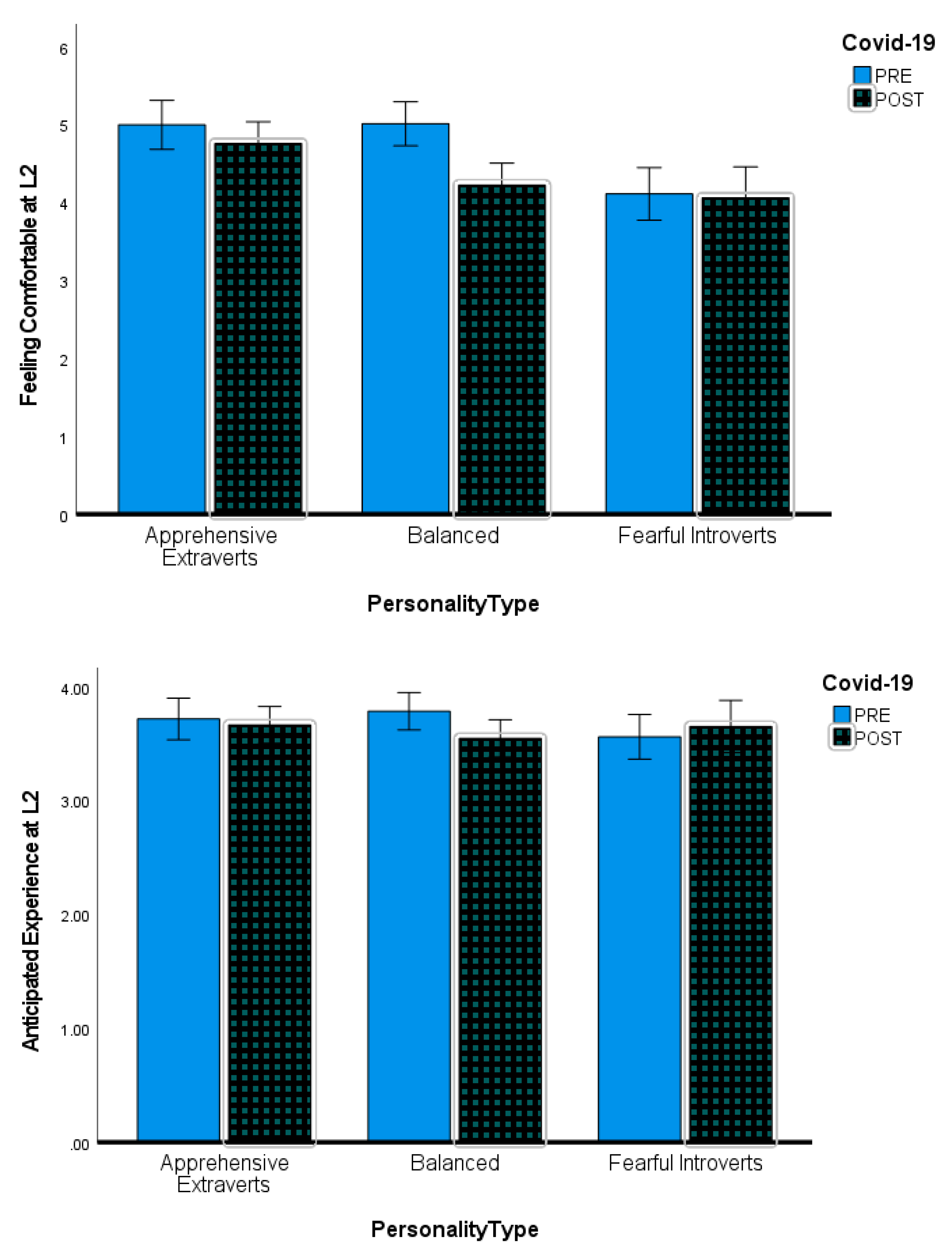
| Respondents’ Characteristics | PRE: n = 218 | POST: n = 220 | ||
|---|---|---|---|---|
| Freq | % | Freq | % | |
| GENDER | ||||
| Male | 125 | 57.6 | 126 | 57.3 |
| Female | 92 | 42.4 | 94 | 42.7 |
| Other | 1 | 0.0 | ||
| AGE | ||||
| 18–24 | 19 | 8.7 | 11 | 5.0 |
| 25–34 | 92 | 42.2 | 106 | 48.2 |
| 35–44 | 53 | 24.3 | 59 | 26.8 |
| 45–54 | 29 | 13.3 | 22 | 10.0 |
| 55–64 | 16 | 7.3 | 17 | 7.7 |
| 65 and above | 9 | 4.1 | 5 | 2.3 |
| EDUCATION | ||||
| High school or below | 55 | 25.2 | 35 | 15.9 |
| Bachelor or associate degree | 129 | 59.2 | 156 | 70.9 |
| Postgraduate or professional degree | 34 | 15.6 | 29 | 13.2 |
| LOCATION | ||||
| Village or rural area | 18 | 8.3 | 19 | 8.6 |
| City suburb | 53 | 24.3 | 49 | 22.3 |
| Smaller city or town (pop. over 1000) | 60 | 27.5 | 49 | 22.3 |
| Large or medium size city (pop. over 100,000) | 87 | 39.9 | 103 | 46.8 |
| TOURIST ROLE a | ||||
| Family Vacationer | 82 | 37.6 | 106 | 48.2 |
| Nature Lover | 74 | 33.9 | 71 | 32.3 |
| Peace and Quiet Seeker | 66 | 30.3 | 45 | 20.5 |
| Beach Goer | 59 | 27.1 | 61 | 27.7 |
| Variables a | PRE, n = 218 | POST, n = 220 | ||||||
|---|---|---|---|---|---|---|---|---|
| Mean | SD | Skew | Kurt | Mean | SD | Skew | Kurt | |
| Extraversion | −0.48 | 0.83 | −0.57 | 0.14 | −0.36 | 0.74 | −0.71 | 0.17 |
| Neuroticism | −0.40 | 0.97 | −0.21 | −0.01 | −0.50 | 1.01 | −0.33 | −0.42 |
| Openness | 0.39 | 0.47 | 0.04 | −0.28 | 0.32 | 0.52 | −0.26 | 1.01 |
| Conscientiousness | 0.38 | 0.58 | 0.21 | 1.07 | 0.46 | 0.52 | 0.40 | 0.48 |
| Agreeableness | 0.10 | 0.51 | −0.56 | 1.57 | 0.08 | 0.51 | −0.45 | 0.77 |
| L1 | ||||||||
| Perceived crowdedness | 2.34 | 1.85 | 1.13 | −0.16 | 2.44 | 1.87 | 0.95 | −0.55 |
| Being comfortable | 5.96 | 1.32 | −1.80 | 3.77 | 5.80 | 1.45 | −1.25 | 1.10 |
| Anticipated experience | 4.10 | 0.72 | −1.45 | 3.56 | 4.11 | 0.70 | −1.00 | 1.85 |
| L2 | ||||||||
| Perceived crowdedness | 4.43 | 1.37 | −0.28 | −0.32 | 4.74 | 1.31 | −0.42 | −0.19 |
| Being comfortable | 4.75 | 1.48 | −0.42 | −0.34 | 4.40 | 1.69 | −0.30 | −0.79 |
| Anticipated experience | 3.70 | 0.89 | −0.97 | 0.98 | 3.61 | 0.92 | −0.79 | 0.32 |
| L3 | ||||||||
| Perceived crowdedness | 6.33 | 0.90 | −1.48 | 2.81 | 6.34 | 1.00 | −1.69 | 3.21 |
| Being comfortable | 3.05 | 1.89 | 0.50 | −1.06 | 2.86 | 1.92 | 0.64 | −0.98 |
| Anticipated experience | 2.82 | 1.15 | −0.07 | −1.18 | 2.84 | 1.20 | −0.14 | −1.24 |
| Personality Traits | Mean | Cluster 1 | Cluster 2 | Cluster 3 | |
|---|---|---|---|---|---|
| Total Sample | Apprehensive Extraverts | Fearful Introverts | Balanced | ANOVA: | |
| n = 438 | n = 159 | n = 105 | n = 174 | F2, 435 | |
| Neuroticism | −0.45 | 0.05 | 0.38 | −1.41 | 370.53 |
| Extraversion | −0.42 | −0.11 | −1.45 | −0.08 | 253.51 |
| Openness | 0.35 | −0.05 | 0.67 | 0.54 | 138.71 |
| Conscientiousness | 0.42 | 0.10 | 0.57 | 0.63 | 51.89 |
| Agreeableness | 0.09 | 0.01 | −0.17 | 0.32 | 41.18 |
| Study Variable | Repeated-Measure ANOVA | |||
|---|---|---|---|---|
| Perceived Crowdedness | Wilks Λ | F | p-value | Partial η2 (a) |
| Density Level | 0.26 | 1219.75 | <0.001 | 0.736 |
| L1: M = 2.39; L2: M = 4.58; L3: M = 6.33 | ||||
| Feeling of Being Comfortable | Wilks Λ | F | p-value | Partial η2 |
| Density Level | 0.39 | 673.36 | <0.001 | 0.606 |
| L1: M = 5.88; L2: M = 4.58; L3: M = 2.95 | ||||
| Anticipated Experience | Wilks Λ | F | p-value | Partial η2 |
| Density Level | 0.50 | 443.12 | <0.001 | 0.503 |
| L1: M = 4.12; L2: M = 3.65; L3: M = 2.83 | ||||
Publisher’s Note: MDPI stays neutral with regard to jurisdictional claims in published maps and institutional affiliations. |
© 2022 by the authors. Licensee MDPI, Basel, Switzerland. This article is an open access article distributed under the terms and conditions of the Creative Commons Attribution (CC BY) license (https://creativecommons.org/licenses/by/4.0/).
Share and Cite
Dogru-Dastan, H.; Stepchenkova, S.; Kirilenko, A.P. Responding to Visitor Density Pre and Post COVID-19 Outbreak: The Impact of Personality Type on Perceived Crowdedness, Feeling of Being Comfortable, and Anticipated Experience. Sustainability 2022, 14, 3960. https://doi.org/10.3390/su14073960
Dogru-Dastan H, Stepchenkova S, Kirilenko AP. Responding to Visitor Density Pre and Post COVID-19 Outbreak: The Impact of Personality Type on Perceived Crowdedness, Feeling of Being Comfortable, and Anticipated Experience. Sustainability. 2022; 14(7):3960. https://doi.org/10.3390/su14073960
Chicago/Turabian StyleDogru-Dastan, Humeyra, Svetlana Stepchenkova, and Andrei P. Kirilenko. 2022. "Responding to Visitor Density Pre and Post COVID-19 Outbreak: The Impact of Personality Type on Perceived Crowdedness, Feeling of Being Comfortable, and Anticipated Experience" Sustainability 14, no. 7: 3960. https://doi.org/10.3390/su14073960
APA StyleDogru-Dastan, H., Stepchenkova, S., & Kirilenko, A. P. (2022). Responding to Visitor Density Pre and Post COVID-19 Outbreak: The Impact of Personality Type on Perceived Crowdedness, Feeling of Being Comfortable, and Anticipated Experience. Sustainability, 14(7), 3960. https://doi.org/10.3390/su14073960







